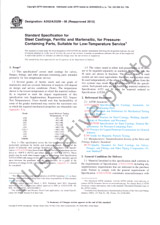We need your consent to use the individual data so that you can see information about your interests, among other things. Click "OK" to give your consent.
ASTM D7417-17
Standard Test Method for Analysis of In-Service Lubricants Using Particular Four-Part Integrated Tester (Atomic Emission Spectroscopy, Infrared Spectroscopy, Viscosity, and Laser Particle Counter)
Translate name
STANDARD published on 1.10.2017
The information about the standard:
Designation standards: ASTM D7417-17
Note: WITHDRAWN
Publication date standards: 1.10.2017
SKU: NS-797718
The number of pages: 9
Approximate weight : 27 g (0.06 lbs)
Country: American technical standard
Category: Technical standards ASTM
The category - similar standards:
Annotation of standard text ASTM D7417-17 :
Keywords:
arc-spark emission spectrometry, baseline, check flush, contaminants, electrodes, infrared spectrometry, in-line dual temperature viscometer, in-service lubricants testing, integrated tester, kinematic viscosity, particle counter, standardization, test standard, wear metals,, ICS Number Code 75.100 (Lubricants, industrial oils and related products)
Additional information
| Significance and Use | ||||||||||||||||||||||||||||||||||||||||||||||||||||||||||||||||||||||||||||||||||||||||||
|
5.1 The integrated tester is primarily used to perform on-site analysis of in-service lubricants used in the automotive, highway trucking, mining, construction, off-road “mining,” marine, industrial, power generation, agriculture, and manufacturing industries. 5.2 The immediate results of analysis of in-service lubricants are critical when performing proactive and preventative maintenance. On-site oil analysis, when used in conjunction with these programs, allows continuous system monitoring and contamination control potentially improving equipment “up-time” and equipment life. |
||||||||||||||||||||||||||||||||||||||||||||||||||||||||||||||||||||||||||||||||||||||||||
| 1. Scope | ||||||||||||||||||||||||||||||||||||||||||||||||||||||||||||||||||||||||||||||||||||||||||
|
1.1 This test method covers the quantitative analysis of in-service lubricants using an automatic testing device that integrates these varied technologies: atomic emission spectroscopy, infrared spectroscopy, viscosity, and particle counting. 1.2 This is suited for in-service lubricating oils having viscosities in the range between ISO 10 and ISO 320 and properties in the ranges given in Tables 1 and 2. TABLE 1 Element Test Parameters Measured, Calculated, and Reported
TABLE 2 Physical Properties Parameters Measured, Calculated, and Reported Note 1: Review Test Method D4739 and D2896 for particular lubricating oil
applications.
1.3 This test method may be used to establish trends in wear and contamination of in-service lubricants and may not give equivalent numerical results to current ASTM test methods. 1.4 This test method is not intended for use with crude oil. 1.5 The values stated in SI units are to be regarded as standard. No other units of measurement are included in this standard. 1.6 This standard does not purport to address all of the safety concerns, if any, associated with its use. It is the responsibility of the user of this standard to establish appropriate safety, health, and environmental practices and determine the applicability of regulatory limitations prior to use. 1.7 This international standard was developed in accordance with internationally recognized principles on standardization established in the Decision on Principles for the Development of International Standards, Guides and Recommendations issued by the World Trade Organization Technical Barriers to Trade (TBT) Committee. |
||||||||||||||||||||||||||||||||||||||||||||||||||||||||||||||||||||||||||||||||||||||||||
| 2. Referenced Documents | ||||||||||||||||||||||||||||||||||||||||||||||||||||||||||||||||||||||||||||||||||||||||||
|
We recommend:
Technical standards updating
Do you want to make sure you use only the valid technical standards?
We can offer you a solution which will provide you a monthly overview concerning the updating of standards which you use.
Would you like to know more? Look at this page.




 Cookies
Cookies
